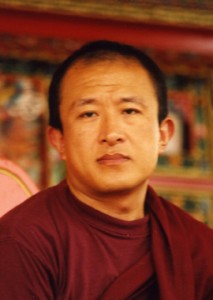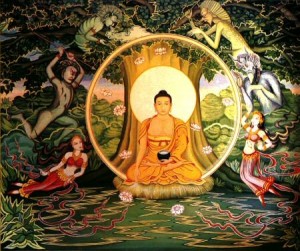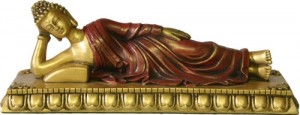
The following is respectfully quoted from “What Makes You Not Buddhist” by Dzongsar Jamyang Khyentse Rinpoche:
Sometimes out of frustration that Siddhartha’s teachings have not caught on enough for my liking, and sometimes out of my own ambition, I entertain ideas of reforming Buddhism, making it easier–more straightforward and puritanical. It is devious and misguided to imagine (as i sometimes do) simplifying Buddhism into defined, calculated practices like meditating three times a day, adhering to certain dress codes, and holding certain ideological beliefs, such as the whole world must be converted to Buddhism. If we could promise that such practices would provide immediate, tangible results, I think there would be more Buddhists in the world. But when I recover from the fantasies (which I rarely do), my sober mind warns me that a world of people calling themselves Buddhists would not necessarily be a better world.
Many people mistakenly think that Buddha is the “God” of Buddhism; even some people in commonly recognized Buddhist countries such as Korea, Japan and Bhutan have this theistic approach to Buddha and Buddhism. This is why throughout this book we use the name Siddhartha and Buddha interchangeably, to remind people that Buddha was just a man and that this man became Buddha.
It is understandable that some people might think that Buddhists are followers of this external man named Buddha. However, Buddha himself pointed out that we should not venerate a person but rather the wisdom that person teaches. Similarly, it is taken for granted that reincarnation and karma are the most essential beliefs of Buddhism. There are numerous other gross misconceptions. For example, Tibetan Buddhism is sometimes referred to as “lamaism,” and Zen is not even considered Buddhism in some cases. Those people who are slightly more informed, yet still misguided, may use words such as emptiness and nirvana without understanding their meaning.
When a conversation arises like the one with my seatmate on the plane, a non-Buddhist may casually ask “What makes someone a Buddhist?” That is the hardest question to answer. If the person has a genuine interest, the complete answer does not make for light dinner conversation, and generalizations can lead to misunderstanding. Suppose that you give them the true answer, the answer that points to the very foundation of this 2,500-year-old tradition.
One is a Buddhist if he or she accepts the following four truths:
All compounded things are impermanent.
All emotions are pain.
All things have no inherent existence.
Nirvana is beyond concepts.
These four statements, spoken by the Buddha himself, are known as “the four seals.” Traditionally, seal means something like a hallmark that confirms authenticity. For the sake of simplicity and flow we will refer to these statements herein as both seals and “truths,” not to be confused with Buddhism’s four noble truths which pertain solely to aspects of suffering. Even though the four seals are believed to encompass all of Buddhism, people don’t seem to want to hear about them. Without further explanation they serve only to dampen spirits and fail to inspire further interest in many cases. The topic of conversation changes and that’s the end of it.
The message of the four seals is meant to be understood literally, not metaphorically or mystically–and meant to be taken seriously. But the seals are not edicts or commandments. With a little contemplation one sees that there is nothing moralistic or ritualistic about them. There is no good or bad behavior. They are secular truths based on wisdom, and wisdom is the primary concern of a Buddhist. That is not to say that we have license to be wicked or immoral.
Broadly speaking, wisdom comes from a mind that has what the Buddhist calls “right view.” But one doesn’t even have to consider oneself Buddhist to have right view. Ultimately it is this view that determines our motivation and action. It is the view that guides us on the path of Buddhism. If we can adopt wholesome behaviors in addition to the four seals, it makes us even better Buddhists. But what makes you not Buddhist?
If you cannot accept that all compounded things or fabricated things are impermanent, if you believe that there is some essential substance or concept that is permanent, then you are not a Buddhist.
If you cannot accept that all emotions are pain, if you believe that actually some emotions are purely pleasurable, then you are not a Buddhist.
If you cannot accept that all phenomena are illusory and empty, if you believe certain things do exist inherently, then you are not a Buddhist.
And if you think that enlightenment exists within the spheres of time, space and power, then you are not a Buddhist.
So, what makes you a Buddhist? You may not even be born in a Buddhist country or to a Buddhist family, you may not wear robes or shave your head, you may eat meat and idolize Eminem and Paris Hilton. That doesn’t mean you cannot be a Buddhist. In order to be a Buddhist, you must accept that all compounded phenomena are impermanent, all emotions are pain, all things have no inherent existence, and enlightenment is beyond concepts.
It’s not necessary to be constantly and endlessly mindful of these four truths. But they must reside in your mind. You don’t walk around persistently remembering your own name, but when someone asks your name, you remember it instantly. There is no doubt. Anyone who accepts these four seals, even independently of Buddha’s teachings, can be considered to be on the same path as he.
When I tried to explain all of this to the man next to me on the plane, I began to hear a soft snoring sound and realized that he was sound asleep. Apparently our conversation did not kill his boredom.
I enjoy generalizing, and as you read this book, you will find a sea of generalizations. But I justify this to myself by thinking that apart from these generalizations we human beings don’t have much means of communication. That’s a generalization in itself.
By writing this book, it is not my aim to persuade people to follow Shakyamuni Buddha, become Buddhists, and practice the dharma. I deliberately do not mention any meditation techniques, practices or mantras. My primary intention is to point out the unique part of Buddhism that differentiates it from other views. What did this Indian prince say that earned so much respect and admiration, even from skeptical modern scientists like Albert Einstein? What did he say that moved thousands of pilgrims prostrate themselves all the way from Tibet to Bodh Gaya? What sets Buddhism apart from religions of the world? I believe it boils down to the fours seals, and I have attempted to present these difficult concepts in the simplest language available to me.
Siddhartha’s priority was to get down to the root of the problem. Buddhism is not culturally bound. Its benefits are not limited to any particular society and have no place in government and politics. Siddhartha was not interested in academic treatises and scientifically provable theories. Whether the world is flat or round did not concern him. He had a different kind of practicality. He wanted to get to the bottom of suffering. I hope to illustrate that his teachings are not grandiose intellectual philosophy to be read and then shelved, but a functional, logical view that can be practiced by each and every individual. To that end I have attempted to use examples from all aspects of all walks of life–from the romantic crush to the emergence of civilization as we know it. While these examples are different from the ones Siddhartha used, the same message Siddhartha expressed is still relevant today.
But Siddhartha also said that his words should not be taken for granted without analysis. So, definitely someone as ordinary as myself must also be scrutinized, and I invite you to analyze what you find within these pages.



